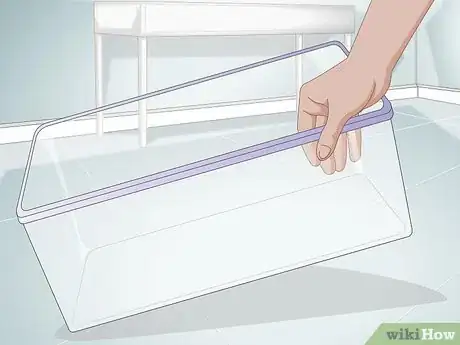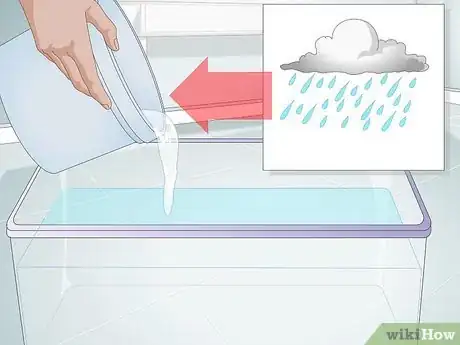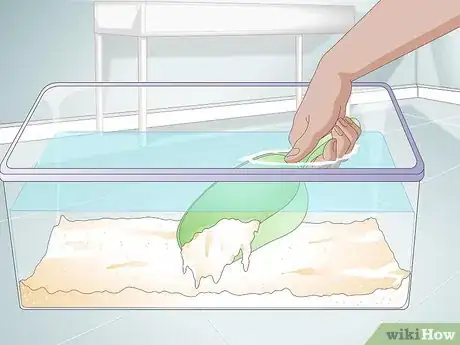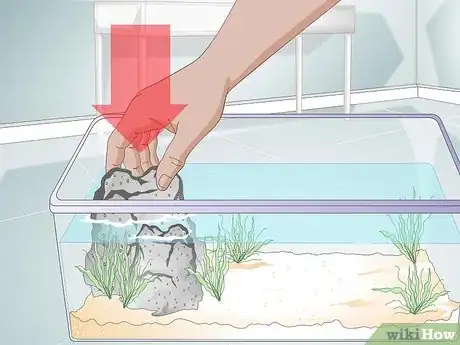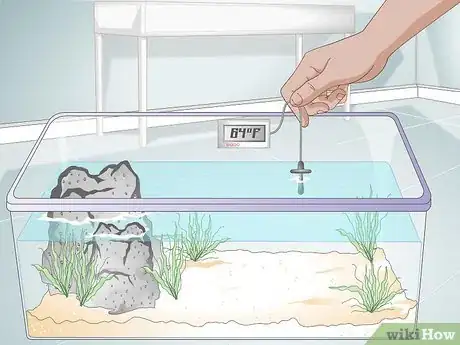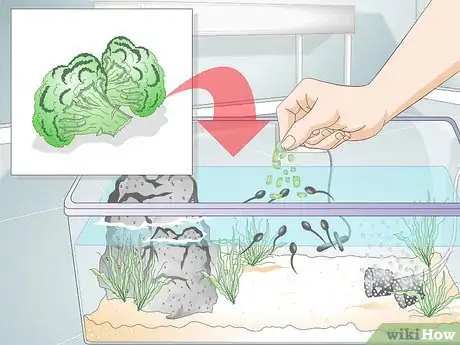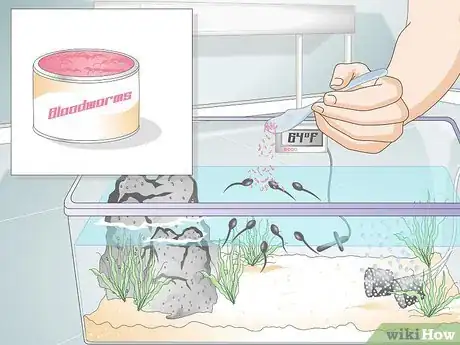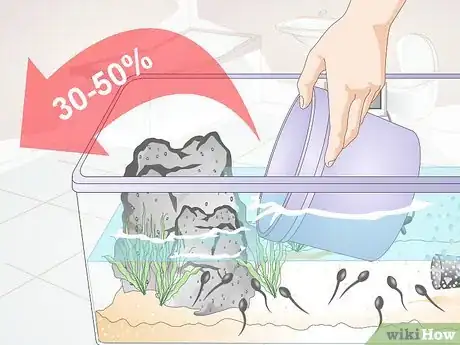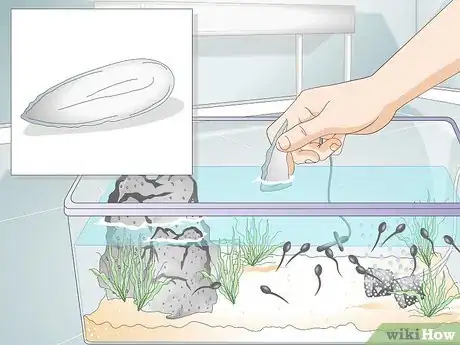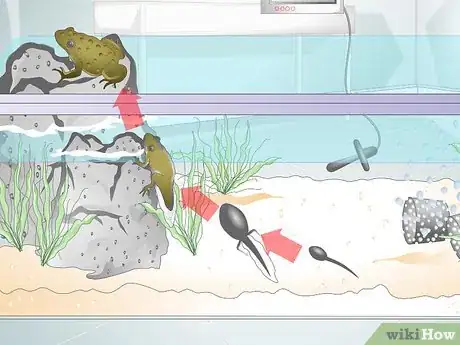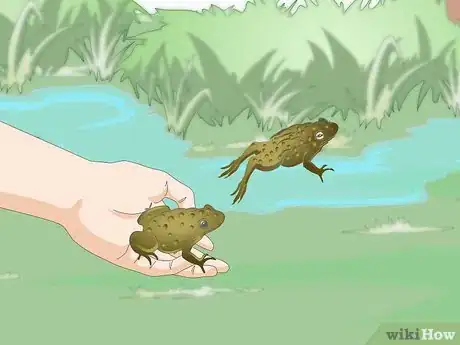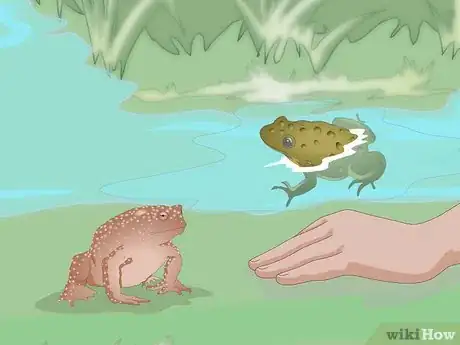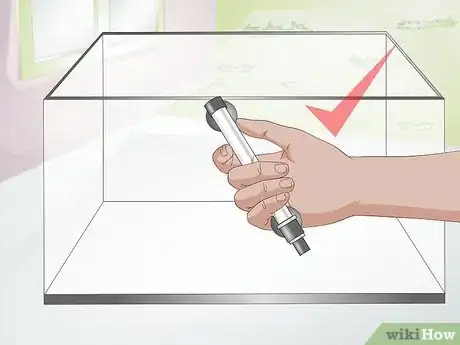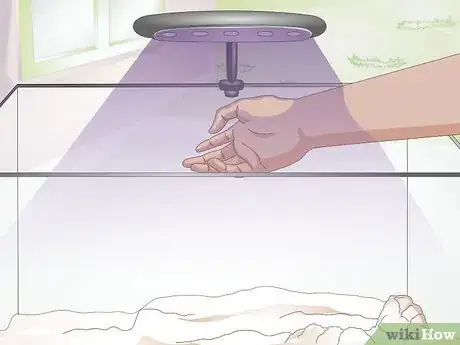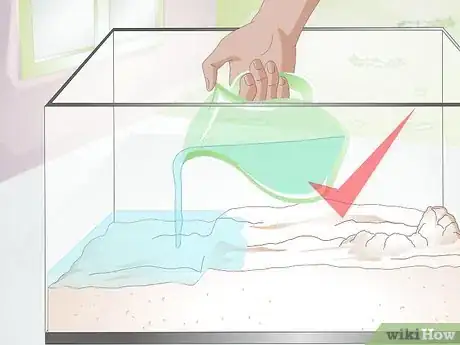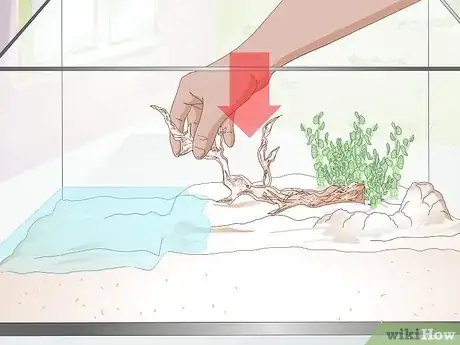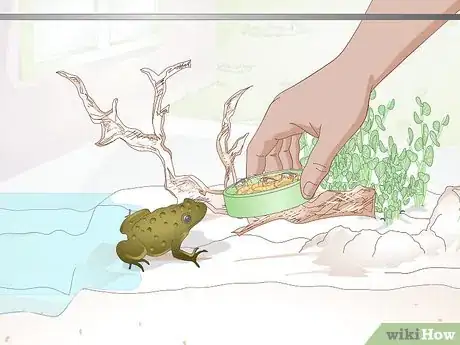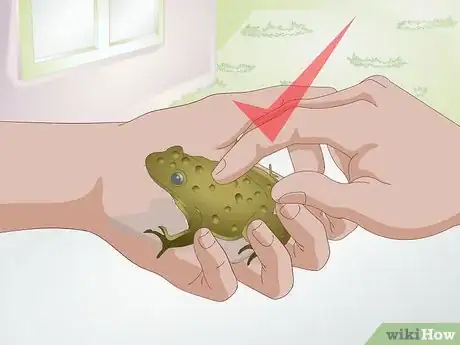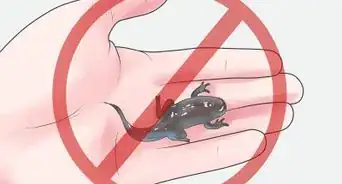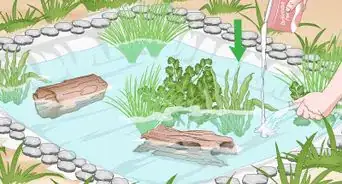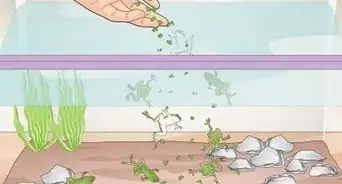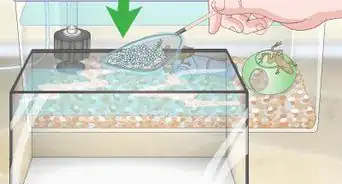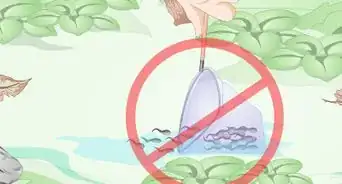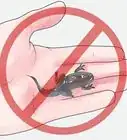wikiHow is a “wiki,” similar to Wikipedia, which means that many of our articles are co-written by multiple authors. To create this article, 28 people, some anonymous, worked to edit and improve it over time.
There are 10 references cited in this article, which can be found at the bottom of the page.
wikiHow marks an article as reader-approved once it receives enough positive feedback. In this case, 94% of readers who voted found the article helpful, earning it our reader-approved status.
This article has been viewed 107,615 times.
Learn more...
Frogs are one of the most diverse type of animals, with several thousand species living everywhere from deserts to underwater. Kids may enjoy catching tadpoles from a nearby creek and raising them until they turn into frogs. Other frog owners enjoy watching an exotic pet develop and live, sometimes for 20 years or more. Because of their incredible variety, and because of national or regional laws limiting frog ownership, research frog species to find out which one is right for you before buying or capturing a pet.
Steps
Creating a Home for Tadpoles
-
1Research laws about raising tadpoles in your area. Many countries and regions require people to apply for an amphibian license before they are legally allowed to raise tadpoles or frogs. Some species may be illegal to raise under any circumstances, usually because they are an endangered species. Search online for information about national and regional laws in your area, or contact a local department of wildlife management or department of natural resources.
- Australia has especially strict laws about raising frogs, and these vary from state to state. A summary of each state's laws can be found here.
- If you are purchasing tadpoles from a pet store, you could ask the store's employees about laws in your area.
-
2Find a plastic or glass container. Short, wide containers are better than tall, narrow ones, because the larger water surface results in more oxygen from the air entering the water.[1] You can purchase a plastic "critter tank" at a pet store, or use any clean plastic or styrofoam container. Do not use any container made of metal, or tap water that runs through copper pipes.[2]
- Try to find a large container to avoid overcrowding your tadpoles. Use a plastic kiddie pool if you are raising a large quantity of them.
- Even frog eggs can die if kept in a small container, although the reasons for this are unclear.[3]
Advertisement -
3Fill the container with pond water, rainwater or dechlorinated tap water. Tadpoles require clean water, and could die if placed in tap water which has not been treated to remove chlorine and other chemicals. Ideally, use water from a pond where tadpoles are swimming, or rainwater. If this is not possible, treat tap water with dechlorination tablets purchased at a pet store, or leave the container of tap water in sunlight for 1–7 days to break down the chlorine.
- Do not use rainwater if you area suffers from acid rain or there are industrial operations nearby.
- If your tap water contains fluoride, you may need additional filters to remove the fluoride before it is safe for tadpoles.
-
4Add sand. Some species of tadpoles forage in the sand for small particles of food, and will thrive in a container with 0.5 inch (1.25 cm) of clean sand at the bottom. You may use small, non-sharp aquarium gravel, or gather sand from a river bank.
- Sand collected from beaches or quarries is not recommended, as it contains harmful levels of salts or other substances. In order to remove these substances, fill small containers (not the tadpole container) halfway with the sand, then to the top with water. Let sit for 24 hours, drain the water away, then repeat with fresh water at least six times.[4]
-
5Add rocks and plants, including a way to climb out of the water. Almost every tadpole species requires a way to leave the water once they have transformed into a frog, as they may no longer be able to remain underwater indefinitely. Rocks that extend above the water surface are a good option. Aquatic plants gathered from a pond or pet store provide more oxygen and a place for tadpoles to hide, but do not cover more than 25% of the water surface, as this prevents oxygen in the air from entering the water.[5]
- Note: Place the rocks near the edge of the tank, as some species of frogs will only look for land at the edge of the water, not the center.[6]
- Do not use plants that have been treated with pesticides or other chemicals, as these could kill the tadpoles.
-
6Keep the temperature constant. Tadpoles, just like aquarium fish, are sensitive to changes in water temperature and could die if moved to a container with a much higher or lower water temperature than the water they came from. If you're buying the tadpoles or eggs from a pet store, ask what temperature you should keep the water at. If you're collecting them from a stream or pond, use a thermometer to measure the temperature of that water. Try to get your new water temperature as close to this as possible.
- If you cannot get an expert to identify your species and offer more precise advice, try to keep your water between 59 and 68ºF (15–20ºC).[7]
- Be prepared to move the container indoors before a frost occurs. Keep the water in partial shade if the weather becomes too hot.
-
7Consider an aquarium aerator. If your container is wide and there are aquatic plants in the sand, but not covering the surface, it likely gains enough oxygen from the air, and an additional aerator could cause the tadpoles to bloat.[8] If you are only raising a few tadpoles, they will usually get enough oxygen even if the conditions are not ideal. If you are raising a large number of tadpoles, and the conditions described don't match your tank, you may wish to add an aquarium aerator to keep air moving through the tank.
-
8Acquire frog eggs or tadpoles. Keeping regional and national laws into account, you may collect the tadpoles or frog eggs from a local pond or stream. Purchasing them from a pet store is another option, but do not purchase exotic or imported species if you intend to release the tadpoles into the wild. Frogs can survive many years and can require a substantial amount of care, so it is recommended that you raise local species only for your first attempt.
- Use a soft net or small bucket to scoop up the tadpoles and place them in a transportable container filled with the water they are swimming in. Tadpoles can be damaged if bumped or scratched, and cannot breathe in air.
- As a rough guideline, each 1 inch (2.5 cm) long tadpole requires 1 gallon (3.8 L) of water.[9] Keep in mind that most tadpoles will grow much larger before they become frogs. Overcrowding the tank can lead to disease or insufficient oxygen.
-
9Add the eggs or tadpoles to the new container, but only once the water temperatures are equal. If your water temperature is different than the temperature of the water they came from, place the container of tadpoles in their old water inside the new container, but keep the container opening above the surface so the two bodies of water don't mix. Leave it there until the temperatures of the two bodies of water have equalized, then release the tadpoles into the larger container.
Caring for Tadpoles
-
1Feed tadpoles small amounts of certain soft, leafy greens. Tadpoles thrive best on a diet of soft plant matter, which should be given to them in small quantities whenever they run out of food. Leaves with algae growing on them can be collected from stream or pond bottoms and fed to the tadpoles. Alternatively, rinse baby spinach (never adult spinach), dark green lettuce, or papaya leaves thoroughly, chop them into small pieces, and freeze them before feeding. You can also feed them very small pieces of peas that have been soaked in luke-warm water and placed on the surface of the water. [10] Check with a pet store employee or online before you feed the tadpoles any other type of plant.
- Fish food flakes are not typically as high quality as straight vegetables, but can be used if they contain mostly spirulina or other vegetable matter, not animal protein.[11] Crush large flakes into tiny pieces and feed a pinch a day.
-
2Feed the tadpoles the occasional insect. While tadpoles should be given a little animal protein occasionally, their digestive systems cannot handle large amounts of it. To keep these protein supplements to safe levels, and ensure that the tadpoles are able to eat them, use frozen food intended for fish fry, such as frozen bloodworms or daphnia.[12] Give these to the tadpoles in small quantities once a week. You may feed them larger quantities of insects once they become frogs, although they may not eat for a short time following the change.
- Fish fry food is available wherever live fish are sold.
-
3Clean the water regularly. Whenever the water becomes cloudy or smelly, or when the tadpoles stay clustered near the top of the tank, it is time to change the water. Make sure to use the same type of water the tadpoles are swimming in, treated with dechlorination tablets if necessary. Leave the new water out until it is the same temperature as the existing water, or the temperature change could kill the tadpoles. Replace 30–50% of the old water with the new water at a time.[13]
- The water will stay cleaner for longer if you don't feed the tadpoles large amounts of food at once. Each serving of food should be gone within 12 hours at most, and then immediately replaced.
- Avoid using aquarium water filters to keep the tank clean, unless you are sure they are too weak to drag the tadpoles in or force them to swim against the current.[14] Sponge filters can be used safely.
-
4Provide calcium. Tadpoles need calcium to grow their skeletons, and may not be able to acquire enough from their regular diet. Pet stores sometimes sell cuttlebone for this purpose, which should be rinsed thoroughly before placing in the container, then left there permanently. Alternatively, use a liquid calcium supplement intended for aquariums, adding one or drops for every quart (liter) of water whenever you change the water.[15]
- Once cuttlebone piece about 2 inches (10 cm) long should be enough for a small tank.
-
5Prepare for metamorphosis. Depending on the species and age, the tadpoles may become frogs within a couple weeks or take several months. Once they develop legs and begin to lose their tail, the froglets should try to exit the water. Have a plan prepared as soon as you start to see changes in your tadpoles:
- Most frogs cannot breathe underwater indefinitely, so be sure they have a rock or other non-metal platform at the edge of the tank to climb onto and reach the air. A few species will fail to climb out on their own, so you may need to lift them out with a soft net once their tails are half gone.[16]
- Attach a secure lid to your tank, with plenty of air holes. Weigh it down with heavy objects if it does not latch shut to prevent the frogs leaping out.
-
6Know how to release the frogs. If you caught your tadpoles locally, you may release the frogs in an area of damp vegetation near the same water source you caught them in. If you cannot release them immediately, keep them in a plastic tank with a cover of leaf litter, and bark pieces large enough to hide under. Do not fill the tank with water, but provide a shallow water dish for the frogs to sit in, and spray the tank's sides with water once a day.[17]
- If you wish to keep raising your frogs, or if you need to care for the frogs for more than a day before releasing them, continue on to the next section.
Caring for Adult Frogs
-
1Find out the needs of your frog species before you acquire the animal. Some species of frogs require extensive care, so make sure you know the needs of your frog species before you acquire a new pet. If you are a beginner, you may wish to start with a non-poisonous species that do not grow to a large adult size.[18] Many frog species don't like to be handled or remain still for large periods of time, which may make them less interesting for children.
- You may wish to choose a local species which you can legally release back into the wild if you change your mind about raising it.
- Be aware that some national or regional governments require an amphibian license or forbid the raising of frogs entirely. Search online for laws which apply to your region.
-
2Learn whether your frog live on land, in water, or both. Many frog species need access to both land and water in order to thrive, which may require a special two-part aquarium tank that allows it to move between the two. Others only require a shallow water dish to sit in, while still others are entirely aquatic and can breathe underwater even in adult form. Make sure you know your frog's needs before setting up a tank.
- If you collected your frogs from the wild, get a biologist or someone from the nearest department of natural resources to identify the species.
-
3Find a glass or clear plastic pet tank. Glass aquarium tanks or terrarium tanks are best suited for most frog species. Clear plastic tanks will work as well, but be aware that some frog species require an ultraviolet light which could damage the plastic over a long period of time.[19] Make sure the tank is waterproof and escape-proof, but also contains plenty of air holes or mesh for ventilation.
- Do not use metal mesh, as the frogs could injure themselves on it.[20]
- For tree frogs and other climbing frogs, pick a large, tall tank with room for place branches and climbing structures.
-
4Maintain the tank's temperature and humidity. Whether or not you need a heater and/or humidifier for your tank depends greatly on your frog species and local climate, so seek expert advice or search online for more information about your species' temperature requirements. If you need to keep the tank to a certain humidity, consider purchasing a hygrometer to measure this number so you can spray the sides with water if it drops too low.
- In a two-part tank setup (air and water), heating the water with an aquarium heater may be the most effective way to keep the tank warm.[21]
-
5Cover the bottom of the tank with natural material. Whether in air or water, the frog needs a natural base to walk on. Once again, the exact way you should accomplish this depends on species. A pet store employee or experienced frog owner who knows your species may recommend sand, gravel, peat, moss, or a mixture of these.[22]
- Burrowing species require a thicker layer to dig into.
-
6Provide an ultraviolet light if necessary. Some frogs require an ultraviolet light for 6–8 hours a day.[23] Research your species to find out if this is necessary, and ask a pet shop employee about which UV light to use. There are many types, some of which may overheat your tank or provide them with the wrong wavelengths of light.[24]
- As for regular artificial lighting, fluorescent lights produce less heat and therefore dry out the frog's skin less quickly than incandescent bulbs.
-
7Provide clean water and change regularly. For land-dwelling species, provide a dish of rainwater or other frog-safe water large enough that the frogs can sit in it up to their shoulders. If the frog species requires a two-part tank or a fully aquatic tank, treat it as you would an aquarium tank. This means using rainwater or other frog-safe water, installing an aquarium aerator and a water filter, and replacing 30–50% of the water with clean water at the same temperature whenever it gets cloudy or bad-smelling. Change once every 1–3 weeks for best results, depending on how crowded the tank is.
- Tap water can be treated with dechlorination tablets and, if necessary, a fluoride filter to make it safe for use by frogs. Do not use tap water if your plumbing has copper pipes, as the trace amounts of copper can be toxic to frogs.[25]
- If your tank is kept warm, as it should be for some species, warm the new cold water to the correct temperature in a stainless steel saucepan. Do not use hot tap water.
-
8Add plants or branches if necessary. Underwater aquarium plants in underwater portions of the tank may help clean and oxygenate the water, and provide hiding places which frogs enjoy. Climbing frogs need natural or artificial climbing branches, while most frog species enjoy hiding spots such as large, upside down bark segments.
-
9Choose a selection of appropriate, live food. Almost all frog species eat live insects in the wild, and sticking to a diet of varied insects is usually a good choice.[26] Worms, crickets, moths, and insect larvae are usually appropriate foods, and many frogs are not picky about what they eat if they are not used to a particular diet already.[27] However, it is always a good idea to check what your species requires, and to provide it with food appropriate to the size of its mouth. Mice or other non-insect meat can strain the frogs' organs unless they belong to a large species that had adapted to live on this type of protein.
- Do not feed your frog large ants, which are capable of killing frogs.
- Many frogs will not recognize non-moving objects as food, but you could try to feed a frog individual dead insects by holding them near its mouth with a pair of tweezers.
-
10Coat the food in calcium and vitamin supplements for amphibians. Frogs require a source of calcium, vitamins, or both, since they cannot get enough of these nutrients from insects alone. Amphibian vitamin and calcium supplements are available in powdered form for sprinkling on the insects before feeding. There are many brands of supplements available, and the best one to use depends on the frog's diet and characteristics. As a general rule, use separate calcium supplement and vitamin supplement, not past the expiration date, and avoid high-phosphorus supplements if crickets are the frog's main food.[28]
- It may be easiest to place the insects and a small amount of the powder in a container and shake the container around to coat the insects.
-
11Choose feeding times according to age and climate. The exact needs of your frog depends on species, but you may follow these guidelines if you have no specific instructions that match your species. Young frogs may not eat at all immediately after emerging from the water, but will soon begin to eat rapidly, and have food always available to them. Adult frogs are usually fine being fed once every three or four days, eating 4–7 insects appropriate for their size. During cooler weather, frogs do not require as much food.[29]
- Remove dead insects floating in the water whenever you see them.
-
12Know how to handle your frog. Many frogs do not enjoy being touched, or can even irritate your hands or be damaged by contact with your skin.[30] However, if your frog belongs to a species that is safe to handle and does not squirm or urinate when you pick it up, you may handle it carefully. Research your species to learn whether it is safe to handle. Even if gloves are not required, wash your hands thoroughly before and after handling, rinsing two or more times to remove all traces of soap or lotion.
Community Q&A
-
QuestionIs it safe for tadpoles to live with snails?
 Community AnswerYes. They should coexist nicely.
Community AnswerYes. They should coexist nicely. -
QuestionWhere can I catch blood worms?
 Community AnswerThey probably sell them at your local pet store. I found mine at Petco for my pet fish and used them for my tadpoles, too.
Community AnswerThey probably sell them at your local pet store. I found mine at Petco for my pet fish and used them for my tadpoles, too. -
QuestionCan I put a plastic log in the tank for my frogs to climb on?
 Community AnswerYes. As long as you rinse it well and it has no sharp edges or rough surfaces, it's fine.
Community AnswerYes. As long as you rinse it well and it has no sharp edges or rough surfaces, it's fine.
Warnings
- Remove mosquito larvae living on the surface of the water immediately if you are living in an area with mosquito-transmitted disease.⧼thumbs_response⧽
- Some trees, such as oleander or pine, can drop leaves that harm tadpoles. Keeping your container away from trees will minimize this risk and reduce the amount of cleanup necessary.⧼thumbs_response⧽
- If you see snails in your tadpole tank, remove them immediately and do a full water change immediately. Snails in some areas contain parasites that can cause the tadpoles to grow into deformed frogs.[31]⧼thumbs_response⧽
Things You'll Need
- Soft net
- Small container for transport
- Container for longterm tadpole raising (see instructions)
- Rainwater, pond water, or dechlorinated non-fluoride tap water
- Fish food flakes
- Bugs
- Lettuce (opt.)
- Pond weed (opt)
- Large rocks
- Sand or smooth gravel
References
- ↑ http://www.frogsafe.org.au/ponds/raising_tadpoles.shtml
- ↑ http://www.frogsafe.org.au/ponds/raising_tadpoles.shtml
- ↑ http://www.frogsafe.org.au/ponds/raising_tadpoles.shtml
- ↑ http://www.frogsafe.org.au/ponds/raising_tadpoles.shtml
- ↑ http://www.frogsafe.org.au/ponds/raising_tadpoles.shtml
- ↑ http://www.amphibianark.org/pdf/Husbandry/Tadpole%20care%20sheet%20with%20guidelines.pdf
- ↑ http://www.ypte.org.uk/animal/care-of-frogspawn-and-tadpoles/28
- ↑ http://www.pollywogsworldoffrogs.com/Text-html/tadpole-care.html
- ↑ http://www.amphibianark.org/pdf/Husbandry/Tadpole%20care%20sheet%20with%20guidelines.pdf
- ↑ http://www.frogsafe.org.au/ponds/raising_tadpoles.shtml
- ↑ http://www.amphibianark.org/pdf/Husbandry/Tadpole%20care%20sheet%20with%20guidelines.pdf
- ↑ http://www.amphibianark.org/pdf/Husbandry/Tadpole%20care%20sheet%20with%20guidelines.pdf
- ↑ http://www.amphibianark.org/pdf/Husbandry/Tadpole%20care%20sheet%20with%20guidelines.pdf
- ↑ http://www.amphibianark.org/pdf/Husbandry/Tadpole%20care%20sheet%20with%20guidelines.pdf
- ↑ http://www.frogsafe.org.au/ponds/raising_tadpoles.shtml
- ↑ http://www.frogsafe.org.au/ponds/raising_tadpoles.shtml
- ↑ http://www.frogsafe.org.au/ponds/raising_tadpoles.shtml
- ↑ www.pets4homes.co.uk/pet-advice/keeping-frogs-as-pets-what-every-amphibian-owner-should-know.html
- ↑ http://frogs.org.au/x/media/cs-caerulea.pdf
- ↑ http://frogs.org.au/x/media/cs-caerulea.pdf
- ↑ http://frogs.org.au/x/media/cs-caerulea.pdf
- ↑ https://www.vetbabble.com/small-pets/frog-care-guide/
- ↑ http://www.drsfostersmith.com/pic/article.cfm?aid=2616#answer_15
- ↑ http://frogs.org.au/x/media/cs-caerulea.pdf
- ↑ http://frogs.org.au/x/media/cs-caerulea.pdf
- ↑ http://frogs.org.au/x/media/cs-caerulea.pdf
- ↑ https://www.vetbabble.com/small-pets/frog-care-guide/
- ↑ http://www.amphibiancare.com/frogs/faq.html
- ↑ http://www.pollywogsworldoffrogs.com/Text-html/frog-feeding.html#often
- ↑ http://www.drsfostersmith.com/pic/article.cfm?aid=2616#answer_15
- ↑ http://www.frogsafe.org.au/ponds/raising_tadpoles.shtml
About This Article
To raise frogs, first you'll need to set up a plastic or glass container that's filled with pond water or dechlorinated tap water, sand, plants, and rocks that will give your frogs a way to climb out of the water. Then, you can introduce frog eggs or tadpoles to the container. Feed tadpoles a small amount of leafy greens, like baby spinach and dark green lettuce, whenever they're low on food. You can also give them a few frozen bloodworms or daphnia once per week for protein. Also, put cuttlebone in the tank so your tadpoles get the calcium they need to grow. To learn how to care for frogs during metamorphosis, scroll down!

